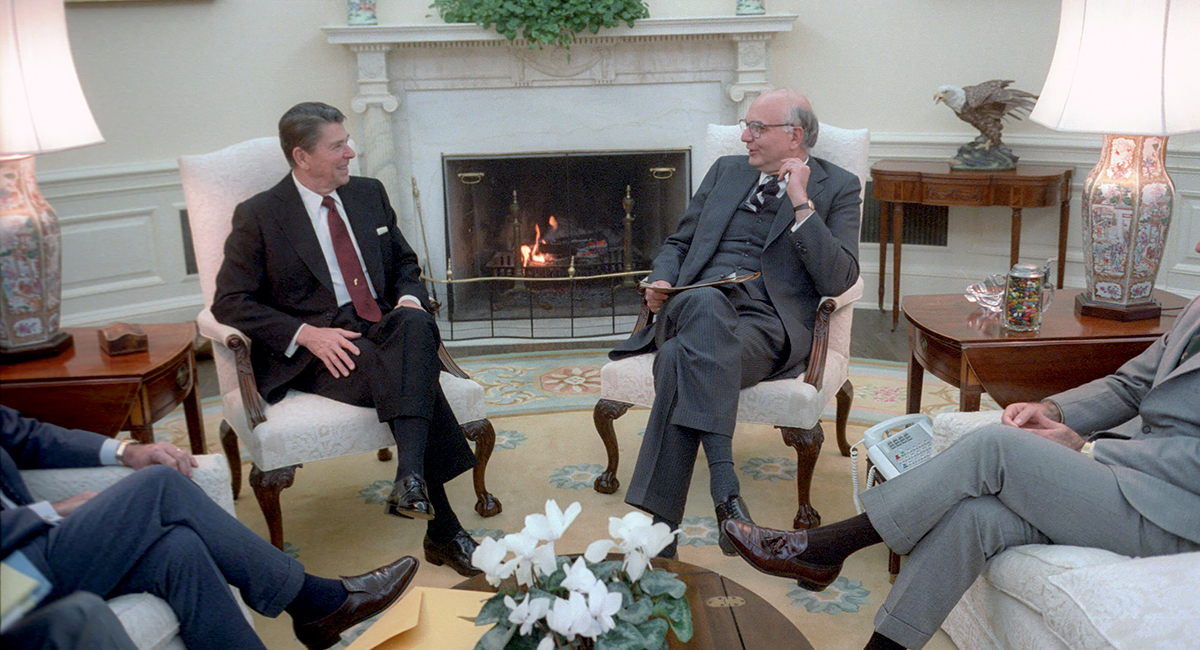Now that the U.S. economy seems to be turning the corner on the worst inflation in 40 years, it’s important to remember that sound money and sound finances go hand in hand. While the Federal Reserve will continue to focus on reducing demand through restrictive interest rates, Congress should concentrate on expanding supply. Yet it all needs to be accomplished while also pursuing a balanced budget.
Sound impossible? Going back those 40 some years, we can draw lessons not only about how to coordinate monetary and fiscal policy effectively. We can also see how former Fed Chairman Paul Volcker endorsed the pro-growth objectives of the Reagan administration while maintaining the independence of the Federal Reserve.
When inflation upends budgetary projections and financial planning, both at kitchen tables across the nation and throughout the halls of government, it needs to be confronted. The U.S. central bank has stood ready to accept responsibility for stable prices since 1977, when Congress specifically mandated that it “promote effectively the goals of maximum employment, stable prices, and moderate long-term interest rates” through an amendment to the Federal Reserve Act.
Volcker was powerfully aware of this assignment and committed to fighting inflation when he was nominated by President Jimmy Carter to lead the Fed in 1979. Under Volcker, the Fed sought to restrain money supply growth by targeting the level of bank reserves in the system, allowing the daily interest rate to fluctuate. When Ronald Reagan was inaugurated as president in January 1981, the effective federal-funds rate exceeded 19% and unemployment stood at 7.5%.
The Reagan administration’s program for economic recovery announced on Feb. 18, 1981, took aim at reversing the debilitating effects of inflation by revitalizing economic growth. The plan acknowledged the importance of a stable and reliable monetary framework as part of an integrated and comprehensive economic program, but its primary thrust was to release the strength of the private sector and “rekindle the nation’s entrepreneurial instincts and creativity.”
The Reagan plan consisted of four parts: “(1) substantial reduction in the growth of federal expenditures, (2) significantly reduced federal tax rates, (3) prudent relief of federal regulatory burdens, and (4) a monetary policy on the part of the independent Federal Reserve System consistent with those policies.”
Concerned about the rising government presence in the economy, the plan emphasized the importance of productive growth from the supply side:
“The goal of this Administration is to nurture the strength and vitality of the American people by reducing the burdensome, intrusive role of the federal government; by lowering tax rates and cutting spending; and by providing incentives for individuals to work, to save, and to invest. It is our basic belief that only by reducing the growth of government can we increase the growth of the economy.”
One week later, on Feb. 25, in testimony before the Senate Banking Committee, Volcker alluded to the pillars for economic recovery identified by the Reagan administration. “As things stand, the tax burden is rising,” he affirmed. “Yet, in principle the need for tax reduction—tax reduction aimed to the maximum extent at incentives to invest, to save, and to work—has come to be widely recognized.”
Volcker commended the Reagan administration’s efforts to reduce the regulatory burden, echoing the program’s recommendation to subject regulatory actions to cost-benefit analysis. “Regulatory and other governmental policies have tended to increase costs excessively and damage the flexibility of the economy,” the Fed chief stated. “But realization of the need to redress the balance of costs and benefits is now widespread.”
The strongest point of agreement between Volcker and Reagan centered on the need to reduce government spending drastically. “I know that the case is sometimes made that monetary policy can alone deal with the inflation side of the equation,” Volcker explained. “But not in the real world—not if other policies pull in other directions, feeding inflationary expectations, propelling the cost and wage structure upwards, and placing enormous burdens on financial markets with large budgetary deficits into the indefinite future.”
Citing the critical need to cut back the surge in government expenditures as the “linchpin” of any effective economic program, Volcker called for bringing the federal budget into balance as soon as possible. At the same time, he noted: “That objective cannot be achieved in a sluggish economy.”
All of which is instructive when applied to the current fiscal and monetary situation facing the nation—and the pending impasse in Washington over how to gain control over government spending while laying the base for renewed growth and productivity. The vital task is to combine monetary restraint with responsible budgetary decisions that increase the long-run prospects for improved prosperity.
While deficit spending is an affront to the notion of sound money and compromises the role of central banking in funding government, there’s a difference between fiscal outlays for current consumption—financed by yet-to-be-realized budget revenues—and tax incentives that will spur more production down the road. Government borrowing to finance socialist redistribution isn’t the same as government borrowing to invest in entrepreneurial capitalism.
And the next time current Fed Chairman Jerome Powell intones that “price stability is the responsibility of the Federal Reserve,” he should recall that his predecessor didn’t demur from telling Congress: “Cutting spending may appear to be the most painful part of the job—but I am convinced that the pain for all of us will ultimately be much greater if it is not accomplished.”









